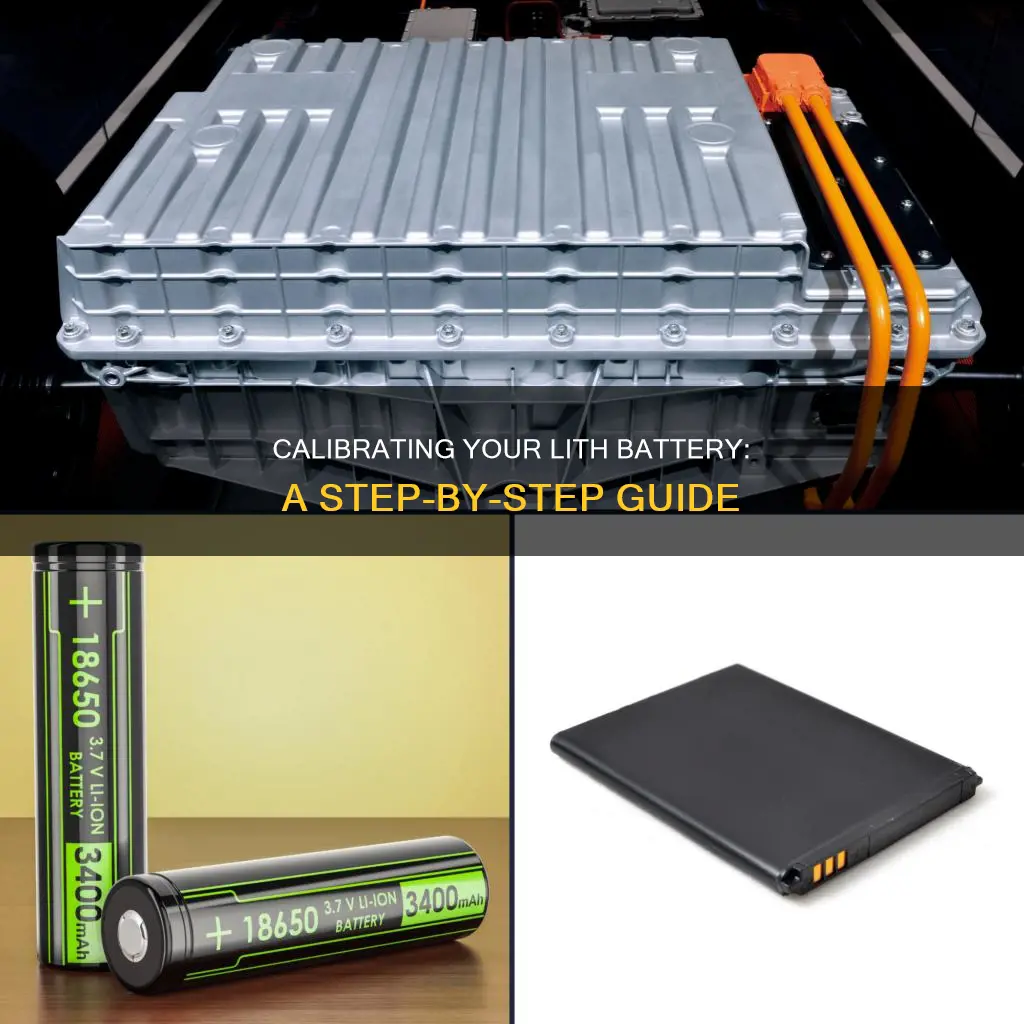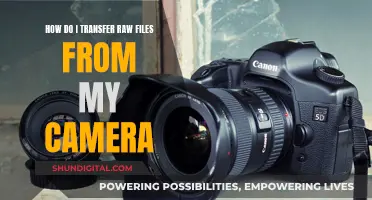
Recalibrating a camera battery is a process that helps to ensure the device accurately reflects the actual battery levels. It involves allowing the battery to run from 100% capacity to almost empty and then charging it back to full. This process helps the battery's power meter to understand how much charge is left in the battery and provide more accurate readings. Recalibration is particularly useful when the device starts shutting down unexpectedly or shows a sudden decline in battery life. However, it is important to note that this process should not be performed frequently as excessive calibration can be detrimental to the battery.
| Characteristics | Values |
|---|---|
| When to calibrate | When the battery blinks to indicate it needs to be done, or when the behaviour of the battery indicates something is wrong. |
| How often to calibrate | Every two to three months, or when the battery suddenly dies without warning. |
| What does calibration do? | It helps your device get an accurate reading of the battery's state of charge. |
| How to calibrate | Let the battery run from 100% capacity to almost dead, and then charge it back to full. |
What You'll Learn
- Calibration is necessary to ensure the camera's power meter is giving an accurate reading of the battery's remaining charge
- Calibration involves running the battery from 100% to almost empty, then charging it back to full
- Calibration should be done every two to three months to ensure accurate battery readings
- Some camera manufacturers include utilities that will calibrate the battery for you
- Calibration does not extend the life of the battery but can prevent unexpected shutdowns

Calibration is necessary to ensure the camera's power meter is giving an accurate reading of the battery's remaining charge
For example, your camera might indicate that the battery is at 30% capacity when, in reality, it is at 1%. This can be extremely inconvenient, especially if you are in the middle of a shoot or are unable to charge the battery right away. Calibration helps to address this issue by providing a more accurate estimate of the remaining battery power.
The calibration process typically involves discharging the battery from a full charge to almost empty and then recharging it back to 100%. This allows the camera's power meter to understand how long the battery actually lasts and to get a more accurate idea of the remaining capacity. It is recommended to calibrate your camera battery periodically, especially if you notice signs of poor battery life or rapid draining.
It is worth noting that some modern devices may not require battery calibration. For instance, Apple states that calibration is not necessary for newer MacBooks with built-in batteries. Therefore, it is always a good idea to check your device manufacturer's recommendations before proceeding with calibration.
Charging Your SeaLife Camera: A Step-by-Step Guide
You may want to see also

Calibration involves running the battery from 100% to almost empty, then charging it back to full
Calibration is a process that helps your device get an accurate reading of your lithium-ion camera battery's state of charge. It is particularly useful when you notice signs of a problem, such as poor battery life or rapid draining. While it is not necessary to calibrate your battery often, it can be beneficial to run the process once a year to ensure optimal performance.
To calibrate your lithium-ion camera battery, follow these steps:
- Fully charge your battery to 100%.
- Continue charging it for at least two more hours.
- Use your camera until it shuts off due to low battery.
- Charge the battery back to 100% without interruption.
By performing this calibration process, you will reset the chip used to measure your camera battery's condition, ensuring that your device accurately reads the battery's state of charge. This will help prevent unexpected shutdowns and maximise the effective use of your battery.
It is important to note that discharging a lithium-ion battery completely can decrease its life, so calibration should only be done when necessary. Additionally, calibration is not required for all camera batteries. Some models may have a calibration button or option, while others may not.
Charging Enel3e Camera Battery: Alternative Methods to Try
You may want to see also

Calibration should be done every two to three months to ensure accurate battery readings
Calibration is the process of ensuring that your camera battery is accurately reporting its state of charge. This is done by fully charging and discharging the battery, and then recharging it. This process is sometimes automated or can be done manually.
Lithium-ion (Li-ion) batteries have a certain number of charge/discharge cycles in them. They have multiple cells in series, and over time, these cells become fragmented, with some cells more charged than others. This can lead to the battery not being able to reach a full charge or to prematurely indicate a low charge. Calibration helps to reset the chip used to measure battery condition, so the camera is accurately reading battery condition.
While calibration does not extend the physical life of the battery, it does increase the effective life of it. The camera will shut down when the chip in the battery says there's not enough power left. So if the chip isn't reading accurately, it can cause the camera to shut down when there is still some charge left in the battery.
Calibration is not usually required often. It is typically done when you see signs of a problem, such as poor battery life or rapid draining. However, to ensure accurate battery readings, it is recommended to calibrate your camera battery every two to three months. This is especially important if you don't want to be surprised by your camera suddenly dying without any prior warnings.
If you have a newer camera model, calibration may not be necessary at all. Check your camera manufacturer's documentation to learn whether battery calibration is necessary for your device. Some camera models may have a calibration button/option on the charger. If your camera does not have this feature, you can follow a general calibration schedule, such as on the last day of every month that has 31 days.
Rapid Charging: Powering Your Camera in a Flash
You may want to see also

Some camera manufacturers include utilities that will calibrate the battery for you
If your camera manufacturer does not include a utility to calibrate the battery, you can manually calibrate it by following these general steps:
- Fully charge your battery and leave it charging for at least two more hours.
- Use your device until it shuts off due to low battery.
- Charge the battery back to full without interruption.
It is recommended to perform this process periodically, about once a month, to ensure accurate battery readings.
It is worth noting that modern devices may not require manual battery calibration. For example, Apple states that calibration is not required for modern portable Macs with built-in batteries. Always check your device manufacturer's documentation or website to see if battery calibration is necessary and if they provide any specific calibration instructions or utilities.
Charging Your ADT Doorbell Camera: Quick and Easy Steps
You may want to see also

Calibration does not extend the life of the battery but can prevent unexpected shutdowns
Calibration is a way to ensure that your device's battery is accurately reporting its state of charge. This is done by setting new "full charge" and "full discharge" anchors in the battery management system. However, calibration does not extend the life of the battery.
Lithium-ion batteries have a limited number of charge/discharge cycles. Fully discharging and recharging the battery during calibration uses up some of these cycles, which can shorten the battery's life. Therefore, it is generally recommended to calibrate the battery only when necessary, such as when the device shows signs of poor battery life or rapid draining.
It is important to note that calibrating a lithium-ion battery is not the same as resetting or reconditioning it. Calibration only affects the accuracy of the battery percentage reading and does not restore the battery to its original capacity or improve its performance.
Additionally, calibrating a lithium-ion battery can be a time-consuming process, especially if it is done correctly. It typically involves fully charging the battery, fully discharging it, and then charging it again. This process can take several hours, and during this time, the device may not be usable.
In conclusion, while calibration can help prevent unexpected shutdowns by ensuring accurate battery readings, it does not extend the life of the battery. To maintain the health of a lithium-ion battery, it is generally recommended to avoid frequent full discharges and charges, as this can shorten the battery's lifespan. Instead, it is often advised to perform partial charges and discharges whenever possible.
Charging Your Fujifilm Camera Battery: Alternative Methods
You may want to see also
Frequently asked questions
Recalibrating a Li-ion camera battery involves running the battery through a full discharge and recharge cycle to help the device get an accurate reading of the battery's state of charge.
It is recommended to recalibrate your camera battery every two to three months to keep your battery readings accurate. However, if you are not too concerned about having precise battery readings, you can do it less frequently.
You may notice that your camera shuts down unexpectedly or that the battery percentage reading seems incorrect. For example, your camera may shut down even though the battery reads as partially charged.
If your camera battery is consistently losing charge quickly or not holding a charge at all, it may be time to replace the battery. Recalibration is typically done to improve the accuracy of the battery percentage reading rather than to restore battery performance.
Recalibrating your camera battery will not give you longer battery life, and it may not be necessary for newer devices. Additionally, frequent recalibration can shorten battery life as Li-ion batteries have a limited number of charge/discharge cycles.







